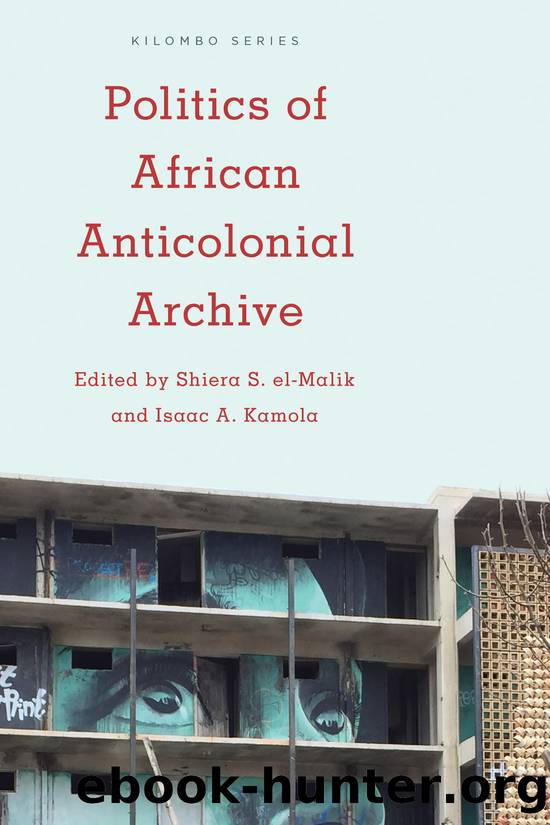Politics of African Anticolonial Archive by el-Malik Shiera S.;Kamola Isaac A.; & Isaac A. Kamola

Author:el-Malik, Shiera S.;Kamola, Isaac A.; & Isaac A. Kamola
Language: eng
Format: epub
Publisher: Rowman & Littlefield Publishers, Incorporated
1. Below is the full table of contents of Azaareâs Recollections of Past Events of British Colonial Rule in Northern Ghana, 1900â1956:
Agurumyela Series
1.Administrative History of the Northern Territories
2.Military Patrols and Punitive Expeditions in the Kassena-Nankana and Frafra Districts
3.Legacies of Colonial Rule in the Kassena-Nankana District
4.Establishment of Military Camps in the Kassena-Nankana District
5.Missionary Activities in Northern Ghana
6.Inter-clan Wars among the Frafras during the Colonial Period
2. AI: Here by âunusualâ Azaare means that Rattrayâs and Cardinallâs anthropological accounts âdo not flow as usualâ and fail to provide sufficient, in-depth understanding of specific clan histories and genealogies. Rather, their books compile research in an arbitrary manner, leaping from one topic to another.
3. Arthur Glyn Leonard, The Lower Niger and Its Tribes (London: Macmillan, 1906), quoted in Francis Arinze, Sacrifice in Igbo Religion (Ibadan: Ibadan University Press, 1970), 31.
4. K.O. Bonsu Kyeretwie, Ashanti Heroes (Accra, Waterville Pub. House, 1964).
5. Quoted in Daily Graphic, 1986.
6. AI: Here âprogressâ, in Azaareâs view, is best understood as a certain level of literacy in oneâs history that is a prerequisite for development, regardless of how communities define the latter term.
7. David Hume, Essays: Moral, Political, and Literary (New York: Cosimo Classics, 2006), 561.
8. Sylvia Leith-Ross, African Women: A Study of the Ibo in Nigeria (London: AMS Press, 1939), 54.
9. Kola, in Gurensi custom, is a symbol of life. A common saying goes âHe who brings kola, brings lifeâ and kola is presented as a gift during visits to traditional authorities.
10. AI: Here Chris Azaare draws a parallel between his research and the work of the soothsayer, who also has to dig into peopleâs past in order to divine effectively.
11. AI: âSkinâ is a term that refers to customary authority in Ghana. Chiefs sit on skins in Northern Ghana and the process of their instalment into office is known as âenskinmentâ. The name given a chief upon enskinment is known as a âskin nameâ. Tindaanas also wear skins as a part of their regalia and are given skin names.
12. Meyer Fortes, The Web of Kinship among the Tallensi: The Second Part of an Analysis of the Social Structure of a Trans-Volta Tribe (International African Institute, Oxford University Press, 1949), 28.
13. AI: This discussion addresses the problem of interrupting male lineage.
14. âConflict Resolutionâ, Daily Graphic, Saturday, 1 April 1985 (No.13788), 5.
15. Ibid.
16. The concept was informed by the idea of bringing government to the local, grassroots level but some people used it to spy on their relatives and I was often suspected to be one such spy.
17. NAG â A â ADM8/1/16), (1913) NAG â A â ADM 56/1/288.
18. Enclosure in Gold Coast, No 412 of 12 Oct. 1895.
19. During the colonial era in the Upper East Region the white man was more likely to interact with chiefs and local allies, rather than with tindaanas and clan elders, who were resistant to the colonizersâ presence.
20. PRO Co 879/52 366. Enclosed Report on Mamprusi.
21. NAG-A-ADM 56/1/429.
22. 1894 Report by George Ekem Ferguson.
23. NAG-A-ADM 56/1/38 letter No 54/112/05 of 6/7/06) (proposed Establishment of post in FRAFRA Area).
Download
This site does not store any files on its server. We only index and link to content provided by other sites. Please contact the content providers to delete copyright contents if any and email us, we'll remove relevant links or contents immediately.
Spell It Out by David Crystal(35395)
Life for Me Ain't Been No Crystal Stair by Susan Sheehan(35183)
Cecilia; Or, Memoirs of an Heiress — Volume 1 by Fanny Burney(31443)
Cecilia; Or, Memoirs of an Heiress — Volume 3 by Fanny Burney(31035)
Cecilia; Or, Memoirs of an Heiress — Volume 2 by Fanny Burney(30981)
Professional Troublemaker by Luvvie Ajayi Jones(28999)
The Great Music City by Andrea Baker(22896)
We're Going to Need More Wine by Gabrielle Union(18123)
Twilight of the Idols With the Antichrist and Ecce Homo by Friedrich Nietzsche(17754)
The Secret History by Donna Tartt(16762)
Cat's cradle by Kurt Vonnegut(13954)
Bombshells: Glamour Girls of a Lifetime by Sullivan Steve(13157)
Pimp by Iceberg Slim(12999)
All the Missing Girls by Megan Miranda(12834)
Fifty Shades Freed by E L James(12490)
Talking to Strangers by Malcolm Gladwell(11983)
Norse Mythology by Gaiman Neil(11960)
The Social Justice Warrior Handbook by Lisa De Pasquale(11517)
Underground: A Human History of the Worlds Beneath Our Feet by Will Hunt(11308)
